Yippie-yi-oh – Saddle up for Criterion’s “The Ranown Westerns: Five Films by Budd Boetticher”
- Bill Kelley III

- Jul 23, 2023
- 9 min read
Updated: Aug 2, 2023
4K ULTRA HD REVIEW / HDR FRAME SHOTS
The leathered Randolph Scott was in his late 50s when he starred in Budd Boetticher’s “The Tall T.”
(Click an image to scroll the larger versions)
“THE RANOWN WESTERNS: FIVE FILMS DIRECTED BY BUDD BOETTICHER: THE CRITERION COLLECTION”
4K Ultra HD & Blu-ray, 1957, 1958, 1959, 1960, not rated with violence
Best extra: “Budd Boetticher: A Man Can Do That” (2005) Documentary
FOR DECADES filmmakers Martin Scorsese, Clint Eastwood, Quentin Tarantino, Peter Bogdanovich, and Taylor Hackford have praised the work of director/producer Budd Boetticher. Yet for many, “Boetticher fell under the radar,” Eastwood says during the 90-minute documentary highlighting his life and career.
The Boetticher films that always surface at the top are the seven gritty B-westerns he made in less than four years in the late 1950s starring his tall and chiseled leading man, Randolph Scott. Five of the seven were originally released under Columbia Pictures for Ranown Pictures, a partnership between Scott and producer Harry Joe Brown, filmed at lightning speed – 14 days or less – with a final run time each under 80 minutes.
To celebrate Boetticher’s stamp on the Western genre, his five Columbia films have been assembled into a superb 4K Ultra HD/Blu-ray box set from The Criterion Collection. Sony Pictures subcontracted the 4K scanning of the original 35mm camera negatives with restoration by the folks at Cineric in NYC, while Warner Brothers’ MPI post-production house handled four of the five HDR grading (HDR10 & Dolby Vision). Roundabout Entertainment worked the other.
Strangely, the two MIA Ranown westerns were originally released by Warner – “Seven Men from Now” (1956) the first and considered the best of the collaboration, now owned by Paramount. Scott played a former sheriff hunting the seven men who killed his wife. And, “Westbound” (1958) as Scott plays Union Captain John Haynes transporting a shipment of gold back East to help finance the Civil War effort.
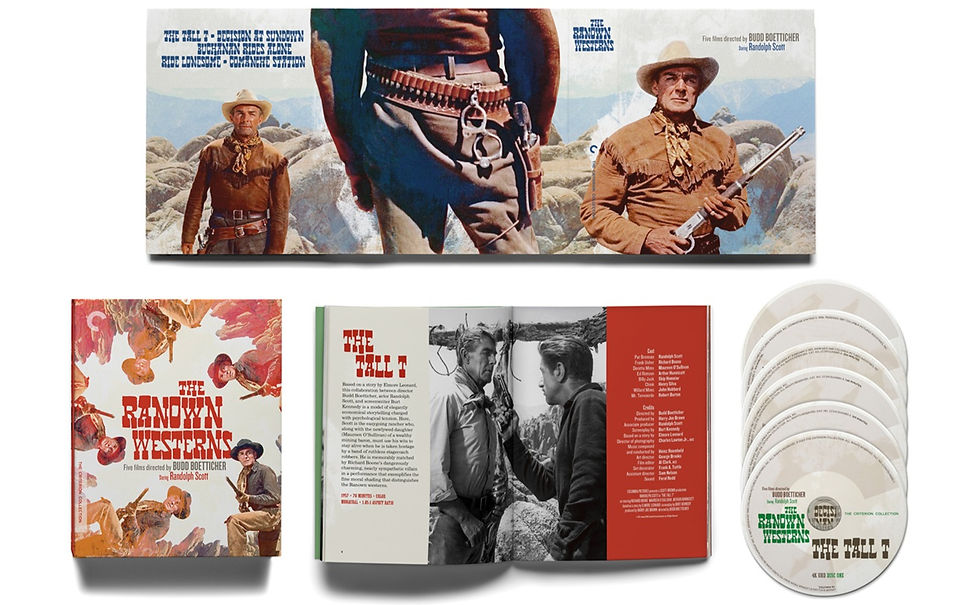
EXTRAS
The Criterion six-disc set includes a 32-page booklet describing why Scott always played the hero in the Boetticher Westerns. “He was stalwart, stoic, and determined. But, on the moral ladder, he stood only one or two rungs above the men he opposed,” writes critic Glenn Kenny in his enclosed essay. The antagonists were the creations of top-notch Western screenwriters Burt Kennedy and Charles Lang. They included soon-to-be-stars Lee Marvin at his sinuous best in “Seven Men from Now”; Richard Boone as killer Frank Usher in “The Tall T” (1957); Craig Stevens as Abe Carbo in “Buchanan Rides Alone” (1958); James Coburn and Pernell Roberts in “Ride Lonesome” (1959) and Claude Akins as bounty hunter Ben Lane in “Comanche Station” (1960).
A supplemental Blu-ray houses five documentaries carried over from previous DVD editions and the UK Powerhouse “Five Tall Tales – Boetticher & Scott at Columbia” Blu-ray box set from 2018. The best is the 90-minute “Budd Boetticher: A Man Can Do That” (2005) hosted by Eastwood and Tarantino and narrated by actor Ed Harris. It opens with Boetticher riding a horse at his California ranch, where the director was a known expert rider and bullfighter. “He’s been my hero for a long time, even before I met him,” Tarantino says. He first encountered the director in the sixth grade, finding Andrew Sarris’ book “The American Cinema: Directors and Directions” (1968) in the school’s library. Boetticher was featured in the section titled “Expressive Esoterica” focusing on auteur theory. The director fills the gaps during the documentary with an interview recorded a year before his death, providing a number of personal stories from childhood, to his college days playing football at Ohio State, until he injured his knee and taught Tyrone Power how to be a matador in “Blood and Sand” (1940).
A separate 37-minute interview “Visiting Budd Boetticher” was recorded at his ranch in 1999, where he recounts seeing his first bullfight in Mexico City and stayed to “became a pretty good bullfighter.” Plus, a 60-minute French TV documentary about Boetticher, as filmmakers Claude Ventura and Philippe Garnier visit Lone Pine, California the location of three of the five films. Then they drove to Boetticher’s ranch, where he tells them he hasn’t visited Lone Pine since the day he finished “Comanche Station” in 1959. Also find a 60-minute interview between Boetticher and Taylor Hackford (1971), who at the time worked for an L.A. Public TV station before becoming a feature film director (“An Officer and Gentleman,” “Ray”).
Criterion produces the only new content with a 25-minute profile of Scott, with film critic Farran Smith Nehme. She underlines the beginning of Scott’s Hollywood career from the 1930s, playing a variety of different roles in dramas, musicals, and screwball comedies which included a personal favorite “My Favorite Wife” (1940) with Irene Dunn and close friend Cary Grant. But, after World War II he turned to mostly B-westerns, “his calling card,” which included six westerns with director André De Toth in the early 1950s. But, as his career neared its end, it took “a beautiful upward arch,” Nehme says. That’s when he partnered with co-producer Brown and Boetticher, and those are “universally regarded as his best.”
The Western tales were scripted with a “turf’s kind of wit,” often by Kennedy, and directed with a “remarkable flare,” Nehme says. The productions were “stripped down to the necessary elements, a man placed in an unfriendly environment, encountering a variety of hostile opponents (outlaws, Native Americans, deserts, and mountains),” writes Professor Tom Gunning in his enclosed essay.
Originally from Virginia and North Carolina and with a distinct southern drawl, Scott was consistently a Top 10 box office star during his Western era. At 58, he saddled up for his first Boetticher western “Seven Men from Now” in the high desert of the Alabama Hills, a rocky volcanic formation on the eastern slope of the jagged Sierra Nevada Range near Mt. Whitney, the highest peak in the contiguous U.S. For nearly a century the stunning location has been a Hollywood favorite, with over 400 movies, 100 TV episodes, and countless TV commercials filmed in and around Lone Pine, California, including Oscar winner “Gladiator” and Marvel’s “Iron Man.”
“The Tall T” (1957, 78 mins. 1.85:1 aspect ratio)
(1) Pat Brennan (Scott) stops by the stagecoach relay station run by Hank Parker (Fred E. Sherman). (2&3) Parker and his son Jeff (Chris Olsen) watch Brennan head toward the town of Contention. (4) Crusty old stage driver Ed Rintoon (Arthur Hunnicutt) (5) Newlyweds Willard Mims (John Hubbard) and his bride Dortetta (Maureen O’Sullivan). (6-8) Brennan returns from Contention and encounters ruthless Frank Usher (Richard Boone) and his two henchmen, trigger-happy Chink (Henry Silva) and vulnerable Billy Jack (Skip Homeier). (9) Chink shoots Mr. Mims. (10) Brennan battles Usher.
“The Tall T”– Boetticher and Scott returned to the Alabama Hills for the first Columbia film featured in the box set. Scott plays struggling rancher Pat Brennan, who encounters the ruthless Frank Usher (Richard Boone) and his two henchmen, trigger-happy Chink (Henry Silva) and vulnerable Billy Jack (Skip Homeier). The three have already killed the stagecoach station master Hank Parker and his young son Jeff. and taken a newlywed couple hostage, Dortetta (Maureen O’Sullivan) a daughter of local miner baron and her cowardly husband Willard Mims (John Hubbard).
The 4K and Blu-ray both include a commentary with film scholar Jeanine Basinger, while the Blu-ray includes an introduction by director Martin Scorsese. He first saw the film at age 11, saying “It had toughness and flintiness so to speak, and spareness that made it unique.”
“Decision at Sundown” (1957, 77 mins. 1.85:1)
“Decision at Sundown” – Scott plays Bart Allison, bent on revenge for his wife’s suicide, and hunts down Tate Kimbrough (John Carroll) the man responsible for her death. She and Kimbrough had an affair while Allison was off fighting in the war. Filmed mostly on a studio back lot subbing for the western town of Sundown and soundstages for interiors, Boetticher and Scott seem out of place away from the open grandeur of the desert. Everyone in town is getting ready for the noon wedding between Kimbrough and fiancée Lucy Summerton played by Karen Steele. She just happened to be Boetticher’s mistress in real life and starred in two more of the seven Westerns.
The Blu-ray includes an introduction by director Taylor Hackford, who called this a “High Noon” type of drama, as the town has been overtaken by greed.
“Buchanan Rides Alone” (1958, 79 mins. 1.85:1)
“Buchanan Rides Alone” – Scott plays mercenary Tom Buchanan, who crosses from Mexico into the corrupt border town of Agry, Texas – controlled by the Agry brothers (Lew, Amos, Roy) and their father Simon, the town judge. Buchanan is quickly framed as an accessory to murder with the vengeful Mexican Juan de la Vega (Manuel Rojas), the son of a wealthy rancher, who killed one of the Agry brothers for attacking his younger sister. This time the production was filmed in Old Tucson, a Hollywood movie set built in 1939, just outside of Tucson, Arizona. The next year, Howard Hawks would film his classic western “Rio Bravo” (1959) starring John Wayne, Dean Martin and Ricky Nelson at the same location.
The Blu-ray includes another introduction by Hackford, who says the film wasn’t officially a Ranown Picture, since Scott was only credited as an associate producer (someone who helps finance a film).
“Ride Lonesome” (1959, 73 mins. 2.35:1)
“Ride Lonesome” – Scott plays bounty hunter Ben Brigade pursuing Billy John (James Best), whose wanted for murder in the town of Santa Cruz. After capturing John, they stumble upon what appears to be an abandoned stagecoach way station. Outlaw Sam Boone (Pernell Roberts) appears ordering Brigade to drop his gun. Then Carrie Lane (Steele), the wife of the station master, emerges with a shotgun telling Boone and his partner Wid (James Coburn) to leave. The duo planned to rob the next stagecoach, but it arrives crashing into the corral. Everyone onboard are dead from an apparent indigenous attack.
Filmed in the super widescreen CinemaScope format from cinematographer Charles Lawton Jr., the visuals are stunning from the Alabama Hills to the nearby sand dunes, especially the opening sequence that runs 140 seconds without an edit. It highlights the lone bounty hunter against the wide-open landscape as the camera pans to the man he’s hunting, drinking his morning coffee on a huge rock formation.
The 4K and Blu-ray features an excellent commentary with writer Jeremy Arnold recorded in 2008, who had become a good friend to Boetticher during the last years of his life. Plus, the Blu-ray includes another introduction by Scorsese who references the lone character played by Scott and how it’s being essential to the history of the western and urban stories like “On Dangerous Ground” (1951) with Robert Ryan and “Taxi Driver” (1976) with Robert De Niro.
“Comanche Station” (1960, 73 mins. 2.35:1)
“Comanche Station” – Scott plays Jefferson Cody, a man who trades $5 in goods and one Winchester for the release of Mrs. Nancy Lowe (Nancy Gates), kidnapped during an attack by the Comanches. Her husband has offered $5,000 for her return dead or alive. Three other hunters want the cash reward including Ben Lane (Claude Akins) who Cody had court-martialed years earlier. Cody says, “If I had my way, they would’ve hung you.”
Again, Boetticher and Lawton used the CinemaScope cameras to capture Scott against the big Western canvas of the Alabama Hills.
Hackford provides the final commentary, who considers Kennedy, “One of the great writers of America cinema,” even though he didn’t get the credit. Plus, the Blu-ray includes the 20-minute Super 8 home movie version from the early 1970s; it’s extremely fuzzy and scratched compared to the exceptional 4K restoration from Sony.
VIDEO
Knowing Sony Pictures supervised this 4K restoration of all five films, we are guaranteed a wonderful 4K viewing experience. Every single mark and scratch were removed, and the integrity of the natural film grain was kept intact from left to right and top to bottom with each and every frame. Overall, the clarity is excellent, especially the wide shots captured on the CinemaScope anamorphic lens and cameras. The only issue is the number of composite transition fades, from two pieces of film creating the fade. The clarity drop is jarring – especially on a supersized screen and when the fades are back-to-back lasting over 60 seconds. The Blu-ray discs are also sourced from the new 4K masters, where the fades are less distracting since the overall imagery is 1080p.
The 4K video bitrates are at very good levels throughout all five films, ranging from 60 Megabits per second and peaking just over 100 Mbps. Four of the films, including “Decision at Sundown” and “Buchanan Rides Alone,” share encoding onto one 100 Gigabit disc, while “Ride Lonesome” and “Comanche Station” are encoded on another 100 Gb disc. “The Tall T” was encoded onto its own disc giving it the highest bitrate level from start to finish. HDR grading has produced a more natural color palette – especially the reds. In the day-for-night scenes, when the negative is exposed to mimic nighttime, the 4K extracts more detail in those dark shadows. Plus, the expanded highlights and midtones have given the clouds over Lone Pine a more visual pop.
The HDR10 peak brightness and average numbers: “The Tall T” peak brightness 490 nits, averages 110 nits; “Decision at Sundown” peak brightness 713 nits, 140 nits; “Buchanan Rides Alone” peak brightness 1000 nits, averages 87 nits; “Ride Lonesome” peak brightness 1000 nits, averages 199 nits; “Comanche Station” peak brightness 382 nits, averages 91 nits.
AUDIO
All five films are presented in their uncompressed original mono soundtrack, which keeps all of the dialogue, music, and gun blasts front and center.
As Randolph Scott rides off into the distance in each of the Columbia films, were reminded that Budd Boetticher clearly made his mark in American cinema.
— Bill Kelley III, High-Def Watch producer
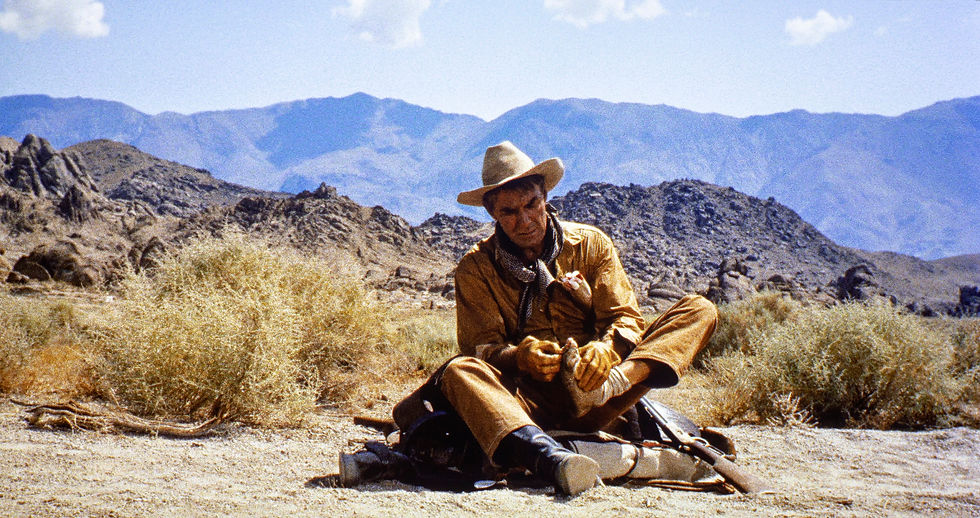
After losing his horse in a beat Pat Brennan tries to fix a hole in his sock during his walk back to the stagecoach relay station.














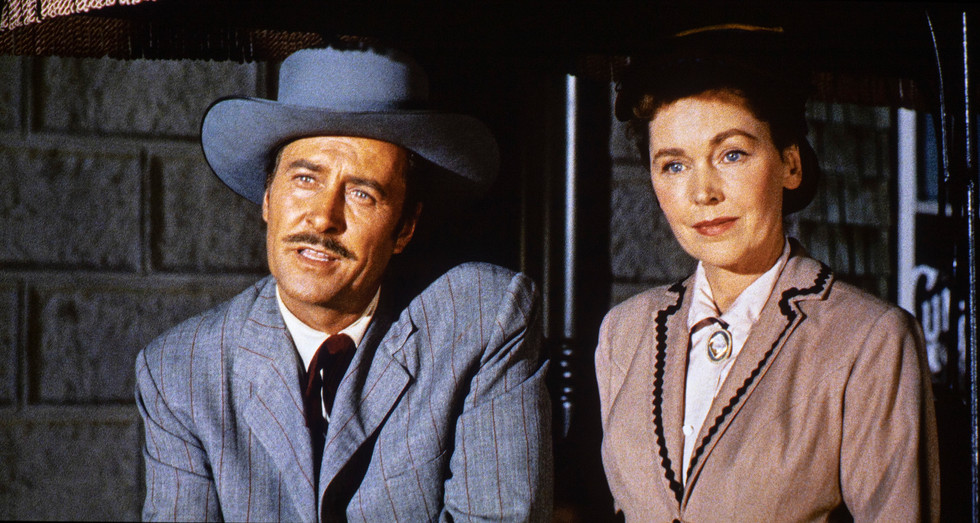

























































































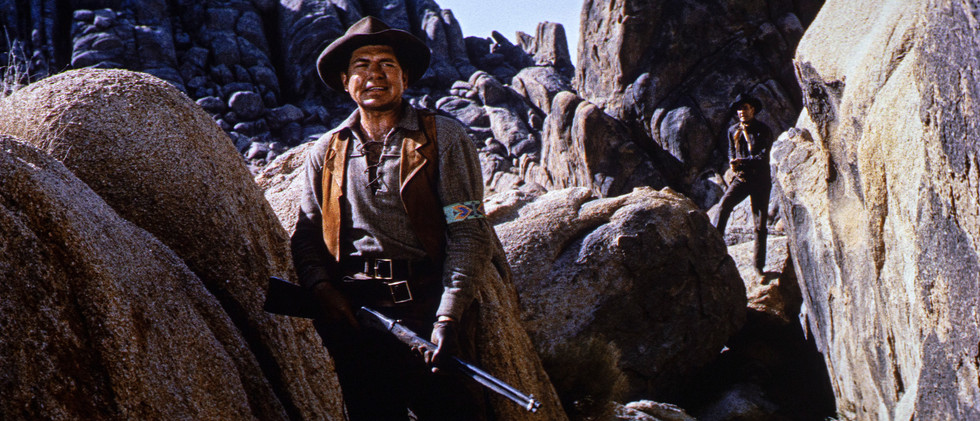
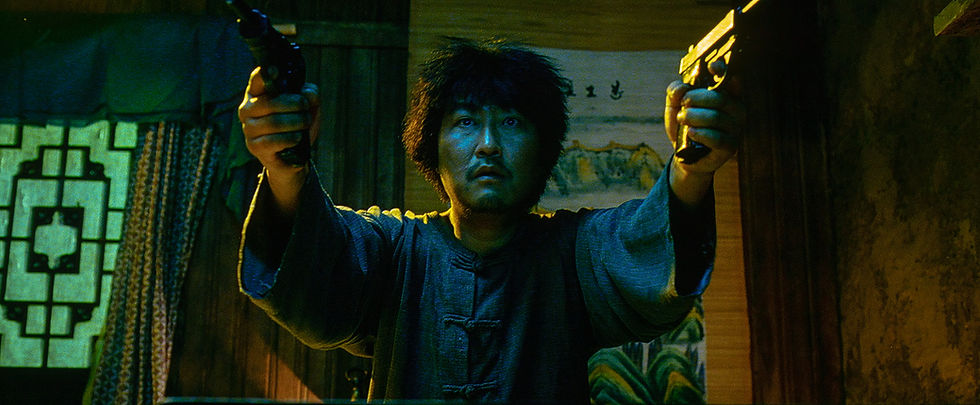


Comments